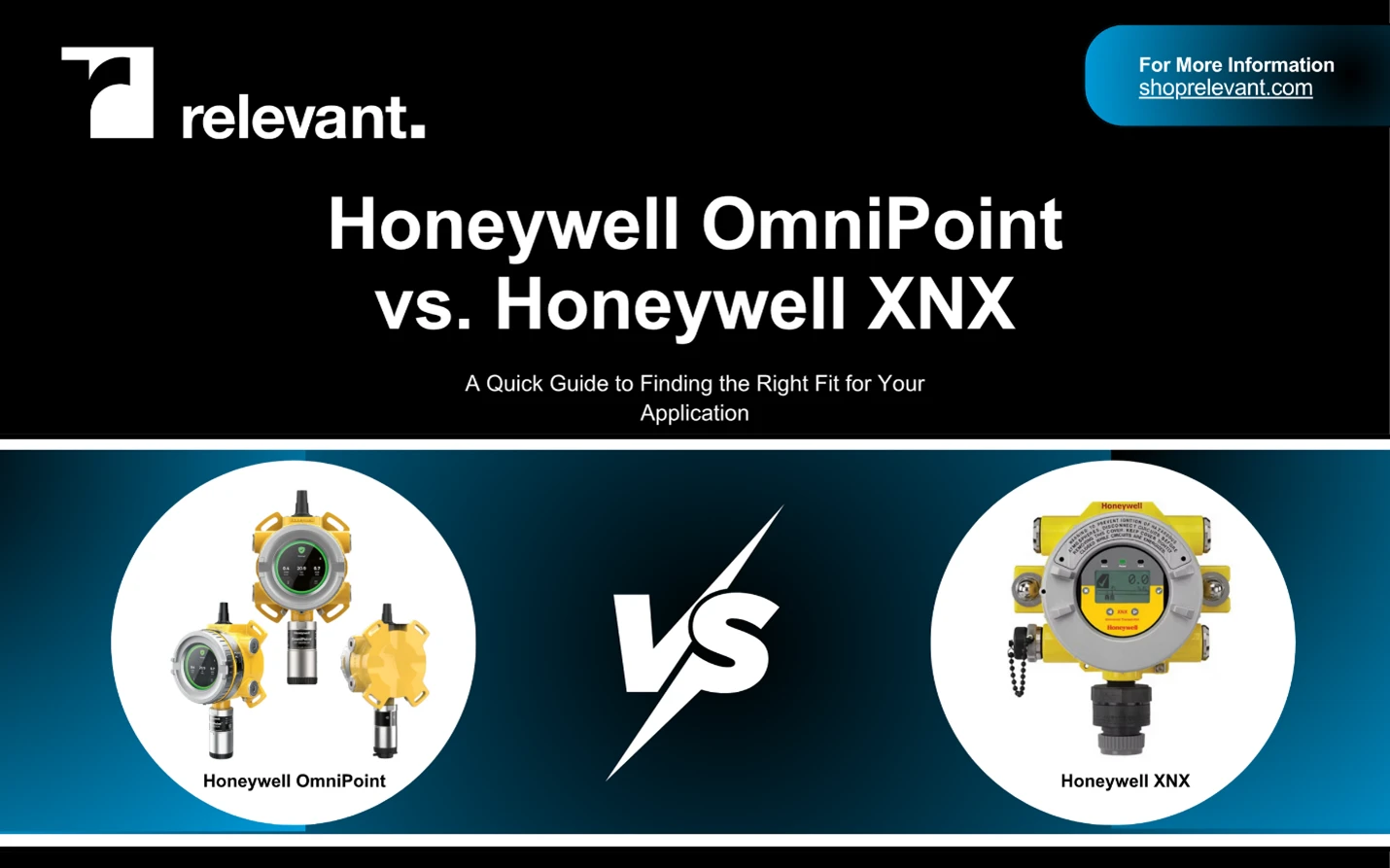Honeywell’s OmniPoint™ transmitter is the next generation of fixed gas detection, designed as a direct upgrade to the XNX™ universal transmitter. While XNX has been trusted for years as a rugged, universal platform, OmniPoint expands its capabilities with multi-sensor support, an intuitive full-color touch display, Bluetooth connectivity, and predictive diagnostics. These upgrades translate into fewer devices in the field, lower maintenance costs, and smarter, faster safety insights for industrial operations.
For decades, the Honeywell XNX Universal Transmitter has been a staple in fixed gas detection. It set the standard for flexibility by accepting a wide range of Honeywell sensors, while withstanding some of the harshest industrial environments. But the industrial workplace is changing—more gases to monitor, higher uptime expectations, and growing demand for digital connectivity. The OmniPoint Transmitter was built to answer those needs. It preserves what made the XNX Transmitter successful, but brings in modern features that reduce costs, improve usability, and deliver more actionable safety data.

Is Honeywell OmniPoint an Upgrade Over the XNX Transmitter?
Both the XNX and OmniPoint Transmitters are rugged, hazardous area transmitters that accept Honeywell’s electrochemical, catalytic bead and infrared gas sensors, but they differ in scope and intelligence. So, how does OmniPoint truly stack up against the legacy XNX? Let’s compare them feature by feature, highlighting where each transmitter shines—and where OmniPoint raises the bar.
Multi-Sensor Capability
XNX:
- Supports one sensor per transmitter
- Accepts catalytic, electrochemical, and IR sensors
OmniPoint:
- Designed as a universal transmitter that monitors up to three sensors (two sensor modules plus one IR detector) simultaneously.
- This flexibility reduces the number of field devices needed, lowering installation costs and simplifying maintenance.
Winner: OmniPoint
– Greater efficiency with fewer devices needed for multi-gas monitoring.
Interface and Ease of Use
XNX:
- Offers a backlit LCD display with textual and bar‑graph indicators, operated via non‑intrusive magnetic switches.
- It’s reliable but less intuitive, and on‑device configuration can be slower.
OmniPoint:
- Features a full‑color LED display with capacitive touch keys and a light ring
- At‑a‑glance status indicators (green for normal, yellow for fault, red for alarm, blue for Bluetooth pairing) help operators quickly assess system health.
- The touch interface—usable even with gloved hands—provides intuitive navigation and eliminates the need for magnets or physical buttons
Winner: OmniPoint
– A more modern and user-friendly interface that reduces operator error.
Connectivity and Remote Access
XNX:
- Supports HART, Modbus, Foundation Fieldbus and relay outputs but lacks native Bluetooth.
- Remote configuration typically requires handheld HART devices
OmniPoint:
- Includes Bluetooth 5.0 support and a companion mobile app for remote configuration, calibration and diagnostics.
- Non‑intrusive setup from ground level, predictive maintenance alerts and automatic reporting.
Winner: OmniPoint
– Adds wireless access that makes fieldwork safer and faster.
Installation & Maintenance
XNX:
- Still rugged (NEMA 4X/IP66), with multiple conduit entries and support for local or remote sensor mounting.
- Sensors can be hot‑swapped and calibration is non‑intrusive, but multi‑gas installations require additional transmitters.
OmniPoint:
- Its modular design and multi‑sensor capability reduce the number of field devices, with multiple mounting options (wall or pipe), IP66/IP67 and NEMA 4X ratings, and materials available in marine‑coated aluminum or stainless steel.
- The optional Bluetooth app simplifies calibration and cut‑over tasks, reducing downtime
Winner: OmniPoint
– Its modular design, multi-sensor capabilities, and the intuitive app make the OmniPoint the clear winner.
Advanced Diagnostics & Predictive Maintenance
XNX:
- Offers self‑test and fault indication, and optional EDDL software for real‑time diagnostic data, but predictive features are not as integrated or user-friendly.
OmniPoint:
- Provides advanced diagnostics and event history through its digital interface.
- Predictive maintenance alerts help facility operators reduce unplanned downtime and optimize calibration schedules
Winner: OmniPoint
– Advanced predictive insights minimize downtime and costs.
Compatibility & Reliability
XNX:
- Supports the full range of Honeywell sensors and provides wide temperature and humidity ranges, with certifications for explosion‑proof and intrinsically safe applications.
- Scaling can be more complex without multi‑sensor capabilities.
OmniPoint:
- Works with all Honeywell sensor technologies and retains global approvals (ATEX, UL, CSA).
- It’s designed for extreme temperatures (–55 °C to +75 °C) and harsh environments.
Winner: OmniPoint
– Matches XNX durability and pushes boundaries with broader ratings and housing options.
Comparisons at a Glance
| Feature | Honeywell XNX Transmitter | Honeywell Omnipoint Transmitter |
|---|---|---|
| Sensor Capacity | Single sensor per transmitter; accepts catalytic, electrochemical or IR sensors | Supports up to three sensors (two sensor modules + one IR) simultaneously |
| User Interface | Backlit LCD display; magnetic switches for configuration | Full-color touch display with light ring; capacitive touch keys |
| Connectivity | 4–20 mA, HART®, Modbus, Foundation Fieldbus; no built-in wireless | 4–20 mA, HART®, Modbus, Foundation Fieldbus; Bluetooth 5.0 for remote setup via mobile app |
| Diagnostics | Self-test, fault indication, optional EDDL software | Advanced diagnostics with event history and predictive maintenance alerts |
| Installation & Housing | Explosion-proof enclosure; multiple conduit entries; NEMA 4X/IP66 | IP66/IP67 and NEMA 4X; wall or pipe mounting; marine-coated aluminum or stainless steel |
| Target Use | Proven universal transmitter for legacy systems and single-point gas detection | Next-generation platform for multi-gas detection, predictive diagnostics and digital integration |
Frequently Asked Questions (FAQ)
How does OmniPoint’s multi sensor capability reduce costs?
By supporting up to three sensors per device, OmniPoint reduces the number of transmitters needed. Fewer devices mean less wiring, fewer junction boxes, and lower installation labour. Maintenance is simplified because each transmitter can be calibrated remotely via the Bluetooth app.
Can OmniPoint Transmitter integrate with existing control systems?
Yes. OmniPoint provides 4–20 mA, HART®, Modbus and relay outputs, allowing it to interface with legacy PLCs and modern distributed control systems just like the XNX.
Is the OmniPoint transmitter suitable for harsh environments?
Absolutely. OmniPoint is available in marine coated aluminum or stainless steel housings and carries IP66/IP67 and NEMA 4X ratings. It operates in temperatures from –55 °C to +75 °C and is certified for hazardous areas.
What if I already have XNX Transmitter units?
The XNX Transmitter remains a reliable product; however, if your facility requires multi gas monitoring or remote diagnostics, OmniPoint Transmitters can be deployed alongside existing XNX units. Both share sensor compatibility, so existing sensors can be reused, making upgrades straightforward.
Final thoughts
At Relevant Solutions, we’ve supplied and supported the XNX transmitter for years. Many customers appreciate its flexibility and ruggedness. However, as safety standards evolve and digital connectivity becomes essential, we’re seeing more industrial operators upgrade to the OmniPoint Transmitter. The ability to monitor multiple gases from a single unit, combined with intuitive controls and remote management, delivers real value—especially in complex facilities where downtime and maintenance costs are critical considerations.
Honeywell’s OmniPoint transmitter builds on the trusted legacy of the XNX by adding multi sensor capability, a modern user interface, Bluetooth connectivity and advanced diagnostics. For industrial professionals responsible for safety and compliance, these enhancements translate into fewer devices, faster maintenance, richer data and a more resilient gas detection network. When it comes to fixed point gas detection, the answer is clear: the OmniPoint Transmitter is the next step forward.


































